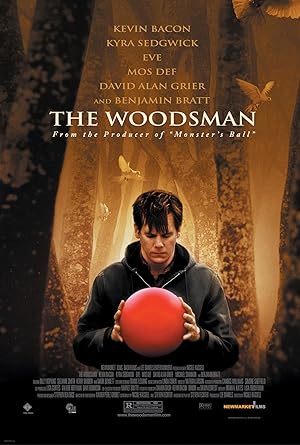I think that I saw The Woodsman starring Kevin Bacon and Kyra Sedgwick when it was in theaters because it was familiar when I watched it late last year. It is about a man adjusting to life in the real world after being released from prison. The unspoken question hovering over every scene is whether or not he can make a life and not transgress. I think that I knew his crime when I saw the film, but I remember that I liked it more in 2004 than I did now. I was motivated to rewatch the film because I did not remember Michael Shannon being in the movie, and he is a national treasure.
The Woodsman is a solid movie. It uses the color red as a symbol of his distorted desire and specifically a red ball that only the main character sees when he is tempted. This red ball is playful and harmless like the veneer that most predators use to lure victims, but the color signals danger. Birds are a symbol of his innocent victims—there are bird feeders, birds in the forest. They are as omnipresent as his victims who ride in a bus with the words yellow bird on the side. Was that for the movie or just a happy accident? It is not a sensational movie, but feels organic and realistic. Bacon and Sedgwick, real life husband and wife, are excellent actors and work well together to create a story about redemption in the face of great odds, which is why I think that the movie is more dangerous now than I did when I originally saw it.
In 2004, I knew less about recidivism rates and had not known many people like the main character, but now I do. While I am no expert, my slight experience has resulted in believing that The Woodsman feels less realistic and more like a highly contrived, sinister fairy tale to elicit sympathy for someone who does not need it. I have met many self-professed guilty convicts of this type. The ones that I met rarely served a lot of time. They not only readjusted more rapidly than others who were guilty of less heinous crimes, but they seemed to flourish and combine new growing families with the old. It is mind-boggling. I think that because we see a handful of high profile cases, we mistakenly conclude that punishment and complete destruction of lives are the normal consequence. Most of them seem unbothered by their past while many of their victims are lost, self-medicating and on the road to oblivion.
I’m not saying that movies should not be made to reflect the inner life of society’s exiles. I am saying that they are not always exiles. It is natural for an audience to root for the underdog, and The Woodsman exploits that by creating a narrative in which the convict is seen as the underdog, a victim of random circumstance, lack of understanding and an unsympathetic society even when he begins to backslide. His recidivism is framed as inevitable consequence of society’s cruelty to him. A rejected potential love interest ruins your reputation so yeah, you show her by…..It vindicates this narrative by making him a protagonist who encounters an external representation of his flaw then beats it to create the fiction that his inclinations are no longer an issue and are completely resolved. The Woodsman wants us to believe that he is normal because look, this formerly abused woman cosigns him so it is a sign that he is on the right track, not that she is recreating past unresolved trauma. A real unflinching look is the unrepentant convict who resumes life unbothered yet seems totally normal, but is surrounded by potential victims, and no one cares. Nothing needs to happen, but it should always feel as if it could. The tension never goes away. It is not if, but when and how.
Stay In The Know
Join my mailing list to get updates about recent reviews, upcoming speaking engagements, and film news.




